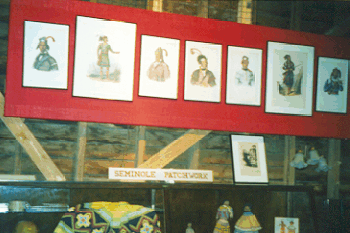

S E M I N O L E W A R C H I E F S


S E M I N O L E W A R C H I E F S
Original oil paintings of important Indians were commissioned by the U. S. Government's Bureau of Indian Affairs, and most were done between 1821-1842 by the famous artist, Charles Bird King. These irreplaceable portraits were destroyed in the Smithsonian fire in 1865. Lithographs done from the paintings were included in the McKenny and Hall publication, "The History of the Indian Tribes of North America." From left to right:
YAHA-HAJO (Mad Wolf) was the second principal war chief of the Seminole nation, and had been among the seven chiefs selected to inspect the western lands reserved for the Seminoles.
OSCEOLA (Asseola, Assyn-ya-hola) was a fearless and cunning leader of the Seminoles who was born in Alabama between 1800 - 1806. His fighting tactics and daring brought many victories to his people over the U. S. Army,
MENAWA (Great Warrior) was a war chief of the Oakfuskee tribe of the Creek Nation. He lived in what is now central Alabama. He worked for the U.S. Army in the war against the Seminoles in Florida.
McINTOSH was born in the Creek Indian nation, in what is now the state of Georgia, about 1785. His father was Scottish and his mother a Creek. He rose to be chief of the Coweta tribe.
CHITTEE YOHOLO (The Snake That Makes a Noise) was a Seminole Chief -who was born in Florida. During the 1830's he participated in numerous attacks on outposts and settlements as the Seminole War escalated.
TUKO-MALTHIA (known as John Hicks) was chief of the Seminole Indians of Florida from 1824-1833. His portrait was painted in 1826 when he was in Washington on a diplomatic mission.
ITCHO YUSTENNUGGE (Deer Warrior) was a chief all the Seminole Indian nation. He, along with Chief Micanopy and five other chiefs, went to Washington in 1826 to confer with President Adams.